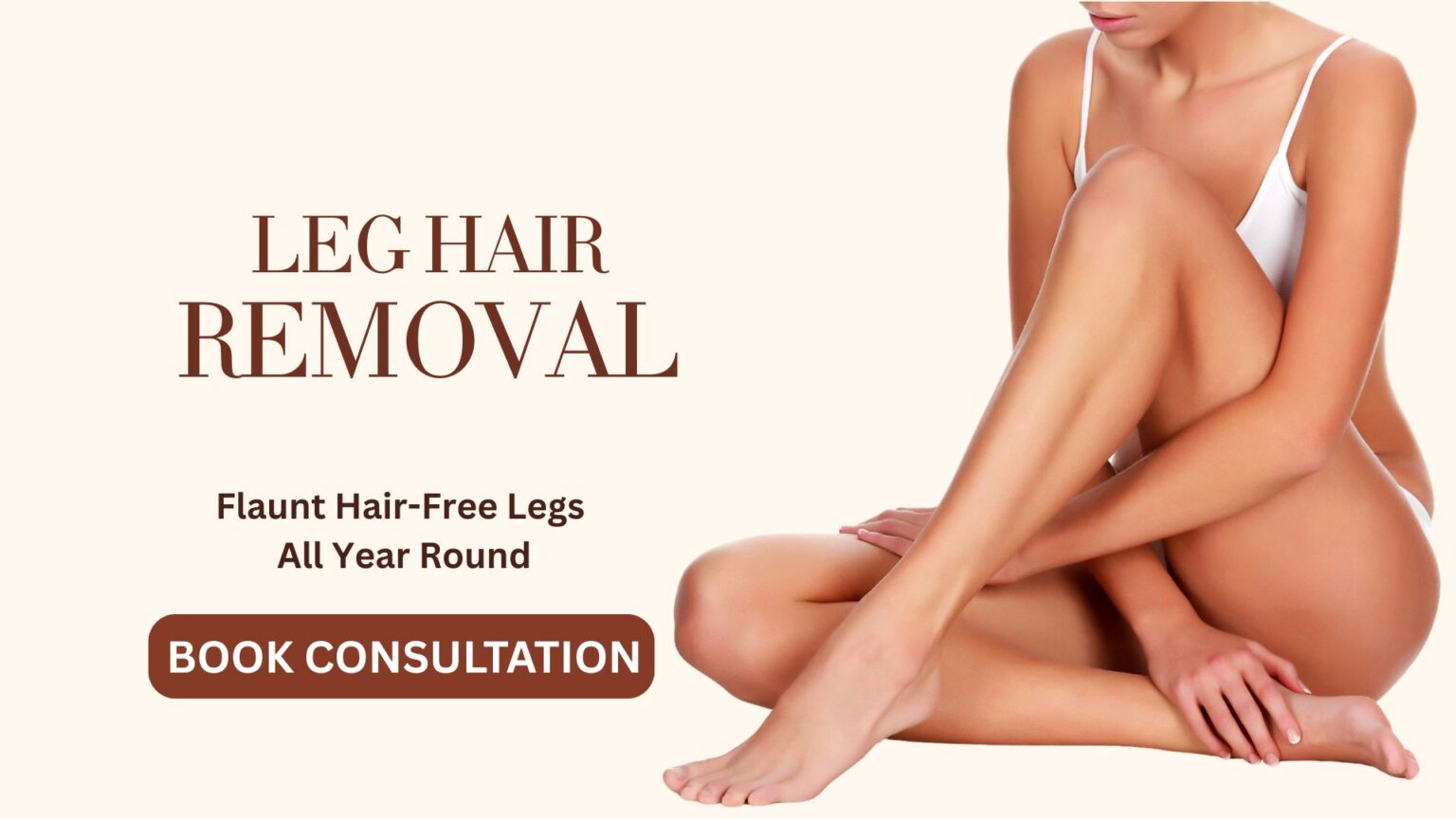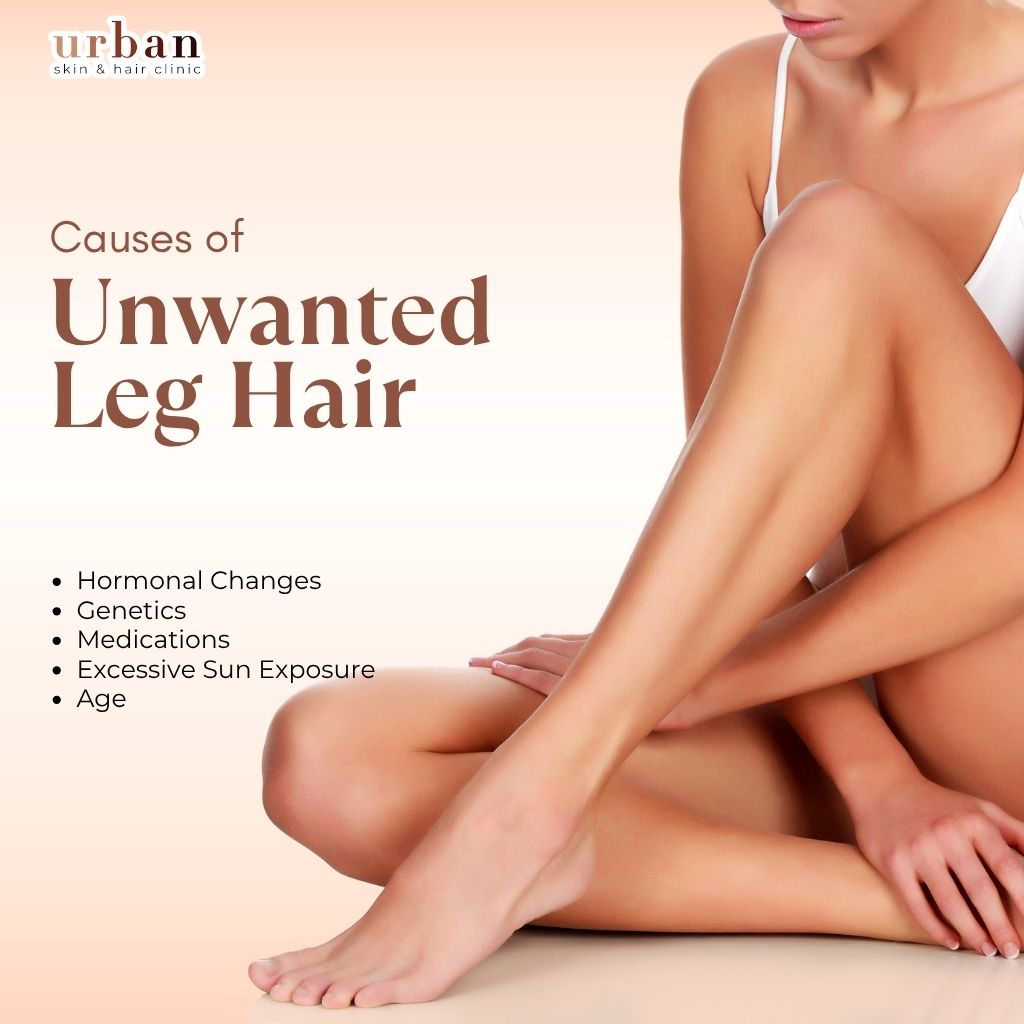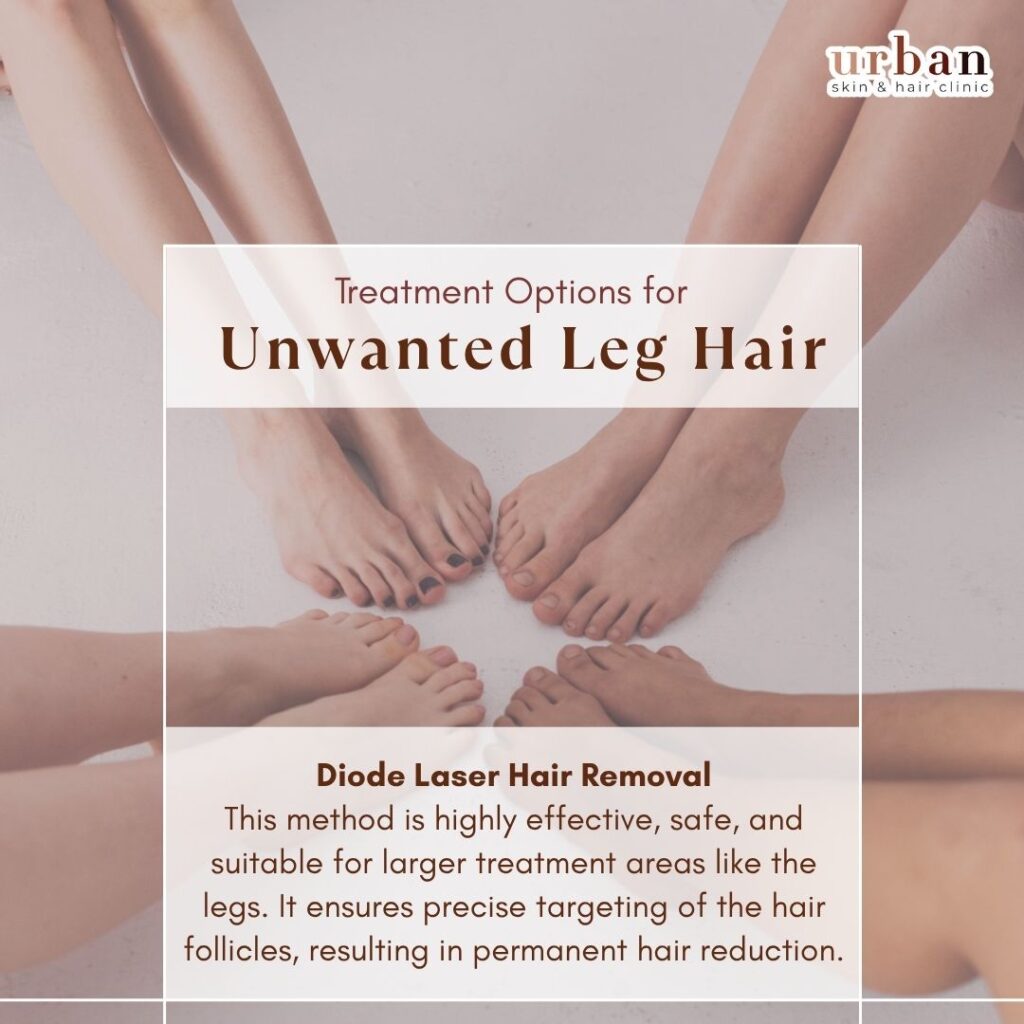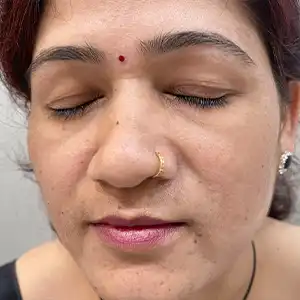

Introduction
Tired of the constant hassle of shaving or waxing your legs? At Urban Skin and Hair Clinic, we offer Laser Hair Removal for Legs, a safe, effective, and long-lasting solution to unwanted leg hair. Our advanced technology ensures a smooth, hair-free look, eliminating the need for frequent shaving or painful waxing, and providing you with silky skin all year round.
What is Leg Hair Removal?
Leg hair removal with laser uses high-energy light to target and destroy the hair follicles in the legs. The laser energy is absorbed by the pigment in the hair, which prevents future hair growth. Laser hair removal is effective for large areas like the legs, providing long-lasting smoothness with minimal downtime.
Causes of Unwanted Leg Hair
Excessive or unwanted hair growth on the legs can result from various factors:
- Hormonal Changes: Fluctuations in hormones due to PCOS, pregnancy, menopause, or puberty can cause increased hair growth on the legs.
- Genetics: Family history plays a role in hair growth patterns. If your relatives have thicker body hair, you might experience similar hair growth.
- Age: Hormonal changes with age can lead to the development of thicker, more coarse leg hair.
- Medications: Certain medications, particularly those that alter hormonal balance, can trigger excessive leg hair growth.
- Excessive Sun Exposure: Sun exposure can darken the pigment of leg hair, making it appear thicker and more visible.

Treatment Benefits
✅ Permanent Hair Reduction: Laser hair removal provides a long-term solution to unwanted leg hair, significantly reducing the need for shaving, waxing, or other temporary methods.
✅ Smooth, Hair-Free Legs: Enjoy soft, smooth, and hair-free legs that are free from the hassle of regular hair removal methods.
✅ Precise and Safe: Our advanced laser technology targets hair follicles without damaging the surrounding skin, ensuring safety and effectiveness.
✅ No Ingrown Hairs: Laser hair removal prevents the common problem of painful ingrown hairs that can occur with shaving or waxing.
✅ Suitable for All Skin Types: Whether you have fair or dark skin, our technology is effective and safe for all skin types, offering optimal results for everyone.
✅ Time-Saving and Convenient: Save time and energy by reducing the need for frequent shaving or waxing sessions, making life simpler and smoother.
Before-After Results
Most patients notice a significant reduction in leg hair after a few sessions. Over time, the hair grows back finer and thinner, with permanent hair reduction typically achieved after 6-8 sessions. Results vary depending on hair thickness, skin type, and individual response to the treatment.

How to Prevent Hair Regrowth
- Follow Your Treatment Plan: Stick to your treatment schedule for optimal results and permanent hair reduction.
- Avoid Sun Exposure: Protect your legs from direct sunlight before and after treatment to avoid pigmentation and irritation.
- Shave Before Your Session: Shave the treatment area before the session to ensure the laser can target the hair follicles more effectively.
- Avoid Waxing or Plucking: Waxing or plucking the hair can interfere with the laser’s ability to target the hair follicles. Shaving is recommended instead.
Treatment Options at Urban Skin and Hair Clinic
We use the most advanced Diode Laser technology for leg hair removal. The benefits of this technology include:
- Diode Laser Hair Removal: This method is highly effective, safe, and suitable for larger treatment areas like the legs. It ensures precise targeting of the hair follicles, resulting in permanent hair reduction.
- Customized Treatment Plans: We assess your hair type, skin tone, and goals to create a personalized treatment plan that offers the best results for your legs.

Introduction
Leg hair removal is a common practice among individuals seeking smooth and hair-free legs. Whether for personal preference, cultural norms, or practical reasons, many people choose to remove the hair on their legs. Leg hair removal methods range from temporary options like shaving and depilatory creams to more long-lasting solutions such as waxing, laser hair removal, or electrolysis. Each method offers its own benefits and considerations, allowing individuals to choose the option that best suits their needs and preferences.
With leg hair removal, individuals can enjoy the freedom to confidently wear skirts, shorts, or swimwear while achieving the desired level of smoothness and hair-free appearance. It’s essential to understand the various techniques, their advantages, and any potential risks or side effects associated with leg hair removal. Consulting with a qualified professional can help determine the most suitable method based on individual factors such as hair type, skin sensitivity, and desired outcomes. With proper knowledge and care, leg hair removal can contribute to feeling comfortable, confident, and ready to show off your beautiful legs.
What is Leg Hair Removal?
Leg hair removal refers to the process of removing unwanted hair from the legs. It is a common practice among individuals who desire smooth, hair-free legs for personal, cultural, or aesthetic reasons. Leg hair removal can be achieved through various methods, including temporary options and more permanent solutions.
Leg Hair Removal Procedure
- Shaving:
- Wet the legs with warm water to soften the hair.
- Apply shaving cream or gel to create a smooth surface.
- Use a clean, sharp razor to gently glide over the skin in the direction of hair growth.
- Rinse the razor frequently to remove hair and debris.
- After shaving, rinse the legs with cool water and pat them dry. Apply a moisturizer to hydrate the skin.
- Waxing:
- Cleanse the legs to remove any lotions, oils, or sweat.
- Heat the wax according to the instructions provided.
- Apply a thin layer of wax in the direction of hair growth using a spatula or wax strip.
- Place a wax strip over the applied wax, pressing it firmly.
- Hold the skin taut and quickly pull the wax strip against the direction of hair growth.
- Repeat the process until all desired areas are treated.
- After waxing, apply a soothing lotion or oil to calm the skin and reduce any redness or irritation.
- Laser hair removal:
- Consult with a professional to determine if you are a suitable candidate for laser hair removal.
- Trim the leg hair to a specific length, if instructed to do so.
- Wear protective eyewear to shield the eyes from the laser.
- The technician will use a handheld device to emit laser pulses onto the targeted areas.
- The laser energy is absorbed by the hair follicles, damaging them and inhibiting future hair growth.
- Multiple sessions are typically required to achieve optimal results.
- After the procedure, apply a cooling gel or lotion to soothe the skin and protect it from excessive sun exposure.
- Electrolysis:
- Consult with a professional electrolysis technician for a thorough assessment and treatment plan.
- The technician will insert a small, fine needle into each hair follicle individually.
- A low-level electrical current is applied to destroy the hair follicles.
- The treated hair is then removed with forceps.
- Electrolysis may require several sessions spaced over time to target all hair follicles.
- Follow the aftercare instructions provided by the technician to promote healing and prevent infection.
Benefits of Leg Hair Removal Treatment
- Smooth and aesthetically pleasing appearance: Leg hair removal provides a smooth and hair-free appearance, enhancing the overall aesthetics of the legs. It allows individuals to feel more confident and comfortable in skirts, dresses, shorts, or swimwear.
- Improved hygiene and cleanliness: Without the presence of leg hair, it is easier to maintain personal hygiene and cleanliness. Leg hair can trap sweat, bacteria, and Odors, but with hair removal, the legs are easier to clean and keep fresh.
- Convenience and timesaving: Leg hair removal eliminates the need for daily shaving or frequent maintenance. Depending on the chosen method, the results can last for weeks or longer, saving time and effort in grooming routines.
- Enhanced sports performance: For athletes or individuals engaged in sports activities, leg hair removal can offer practical benefits. Smooth legs can reduce drag and friction, improving performance in activities such as swimming, cycling, or running.
- Improved application and longevity of skincare products: With leg hair removed, skincare products such as lotions, creams, or self-tanners can be applied more evenly and effectively. Without hair obstructing the skin’s surface, the products can be absorbed more efficiently, maximizing their benefits.
- Reduced ingrown hairs and irritation: Leg hair removal can help minimize the occurrence of ingrown hairs, which can cause bumps, redness, and discomfort. By removing the hair from the root, methods like waxing or laser hair removal can reduce the likelihood of ingrown hairs and associated irritation.
- Personal preference and cultural norms: Many individuals choose leg hair removal as a personal preference or to adhere to cultural norms. It allows them to align with their desired grooming standards or conform to societal expectations.
- Increased self-confidence: Having smooth and hair-free legs can boost self-confidence and self-esteem. It can make individuals feel more comfortable in their own skin and enhance their body image.

Side effects of Leg Hair Removal
- Shaving:
- Razor burn: Irritation, redness, and itchiness may occur if the razor blades are dull, if the skin is sensitive, or if shaving is done too aggressively.
- Cuts and nicks: Accidental cuts or nicks may occur while shaving, especially if not done with caution or with a sharp razor.
- Waxing:
- Pain or discomfort: Waxing can be uncomfortable or painful, particularly for individuals with sensitive skin. The sensation may vary depending on pain tolerance and the area being waxed.
- Skin redness and irritation: The skin may appear red or irritated after waxing, but this usually subsides within a few hours. Some individuals may experience temporary bumps or small red spots.
- Ingrown hairs: Ingrown hairs may develop when new hair grows back and gets trapped beneath the skin’s surface, leading to bumps or inflammation.
- Laser hair removal:
- Skin irritation: Temporary skin redness, swelling, or mild discomfort may occur after laser hair removal. These effects usually subside within a few hours or days.
- Changes in skin pigmentation: Laser hair removal can sometimes cause temporary lightening or darkening of the skin in the treated area. These changes are usually temporary and fade over time.
- Sensitivity to sunlight: The treated skin may be more sensitive to sunlight after laser hair removal, so it’s important to protect the area with sunscreen and avoid sun exposure.
- Electrolysis:
- Redness and swelling: Temporary redness and swelling may occur immediately after electrolysis, but it typically subsides within a few hours.
- Skin sensitivity: Some individuals may experience increased skin sensitivity or a mild stinging sensation during or after electrolysis.
- Potential scarring or skin changes: In rare cases, electrolysis may cause scarring or changes in the texture or pigmentation of the skin.
Pre-Care for Leg Hair Removal
- Choose the appropriate hair removal method: Decide on the hair removal method that best suits your needs and consult with a professional if you’re unsure. Different methods may require specific pre-care instructions.
- Avoid sun exposure and tanning: It’s recommended to avoid sun exposure and tanning beds for at least two weeks prior to the treatment. Sunburned or tanned skin can be more sensitive and prone to complications during the hair removal process.
- Let your hair grow: For methods like waxing or laser hair removal, it’s necessary to have sufficient hair growth. Avoid shaving or trimming the hair in the treatment area for a few weeks before the procedure to ensure there is enough hair to be effectively removed.
- Exfoliate gently: Exfoliate your legs a day or two before the treatment to remove dead skin cells and ensure a smoother hair removal process. However, be gentle to avoid irritating or sensitizing the skin.
- Avoid certain skincare products: Refrain from using any harsh or abrasive skincare products, such as scrubs, chemical peels, or retinoids, on the treatment area for at least a week before the procedure. These products can make the skin more sensitive and increase the risk of irritation or complications.
- Inform the professional about medical conditions and medications: Let the hair removal professional know if you have any medical conditions, allergies, or if you’re taking any medications. Certain medical conditions or medications may require adjustments to the treatment or may affect the suitability of certain hair removal methods.
- Moisturize your skin: Keep your skin well-hydrated by applying a moisturizer regularly in the days leading up to the treatment. Well-moisturized skin can make the hair removal process smoother and more comfortable.
- Stay hydrated: Drink plenty of water to keep your body hydrated. Hydrated skin tends to be more resilient and can handle the hair removal process better.
- Wear loose and comfortable clothing: Choose loose-fitting and comfortable clothing on the day of the treatment. Tight clothing can rub against the freshly treated skin and cause irritation or discomfort.
- Follow specific instructions: If the hair removal professional provides you with specific pre-care instructions, such as avoiding caffeine or certain activities, be sure to follow them diligently.


After Care for Leg Hair Removal
- Keep the treated area clean: Gently cleanse the treated area with mild soap and water. Avoid using harsh or scented products that could irritate the skin. Pat the area dry with a clean towel, avoiding rubbing or scrubbing.
- Apply a soothing and hydrating moisturizer: Use a gentle, non-irritating moisturizer to keep the skin hydrated and nourished. Look for products with ingredients like aloe vera or chamomile, which can help calm and soothe the skin.
- Avoid sun exposure: Protect the treated area from direct sun exposure, as it can increase the risk of sunburn and hyperpigmentation. If you need to go outside, apply a broad-spectrum sunscreen with a high SPF to the treated area and reapply as needed.
- Avoid hot baths or showers: Steer clear of hot baths, showers, or saunas for the first 24-48 hours after the treatment. Hot water can cause skin irritation and may exacerbate any existing redness or sensitivity.
- Avoid excessive heat and sweating: Minimize activities that cause excessive heat or sweating, such as intense workouts or using hot tubs. Sweating can irritate the treated skin and increase the risk of bacterial infections.
- Avoid picking or scratching the treated area: Refrain from picking, scratching, or exfoliating the treated area. Let the hair naturally shed or regrow without interference to prevent potential skin damage or ingrown hairs.
- Avoid tight clothing: opt for loose-fitting clothing to prevent friction or irritation against the treated skin. Tight clothing can rub against the skin, causing discomfort or potential complications.
- Do not use harsh chemicals or exfoliants: Avoid using harsh chemicals, exfoliants, or abrasive products on the treated area for at least a week. These products can further irritate the skin and delay the healing process.
- Follow specific instructions: If the hair removal professional provides you with specific aftercare instructions, such as using a particular post-treatment cream or avoiding certain activities, follow their guidance diligently.
- Contact a professional if necessary: If you experience severe or prolonged redness, swelling, pain, or any unexpected side effects, contact the hair removal professional or a healthcare provider for guidance.
Consult a Specialist Today
Dr. Kiran Chotaliya, M.D. Dermatology, is an expert in autoimmune hair loss treatments, including Alopecia Areata. With a compassionate approach and extensive clinical experience, Dr. Kiran will guide you through every step of the treatment process to ensure the best possible outcome.
FAQ for Leg Hair Removal
Typically, 6-8 sessions are required for optimal results, with each session spaced several weeks apart. The number of sessions may vary depending on hair thickness and skin type.
Laser hair removal is relatively painless. You may feel mild discomfort during the treatment, but it’s significantly less painful than waxing or shaving.
Yes, the Diode Laser technology used for leg hair removal is safe and effective for all skin types, including sensitive skin.
Side effects are rare but may include mild redness or swelling, which usually resolves within a few hours after the procedure.
Yes, shaving is safe after laser hair removal. However, avoid waxing or plucking, as they can disrupt the effectiveness of the treatment.
Why Urban Skin and Hair Clinic

TEAM OF CERTIFIED DERMATOLOGISTS

US-FDA APPROVED EQUIPMENTS

HIGHLY STANDARDISED PROTOCOLS

1 LAKH + HAPPY CLIENTS
Leg Hair Removal Results Before & After










